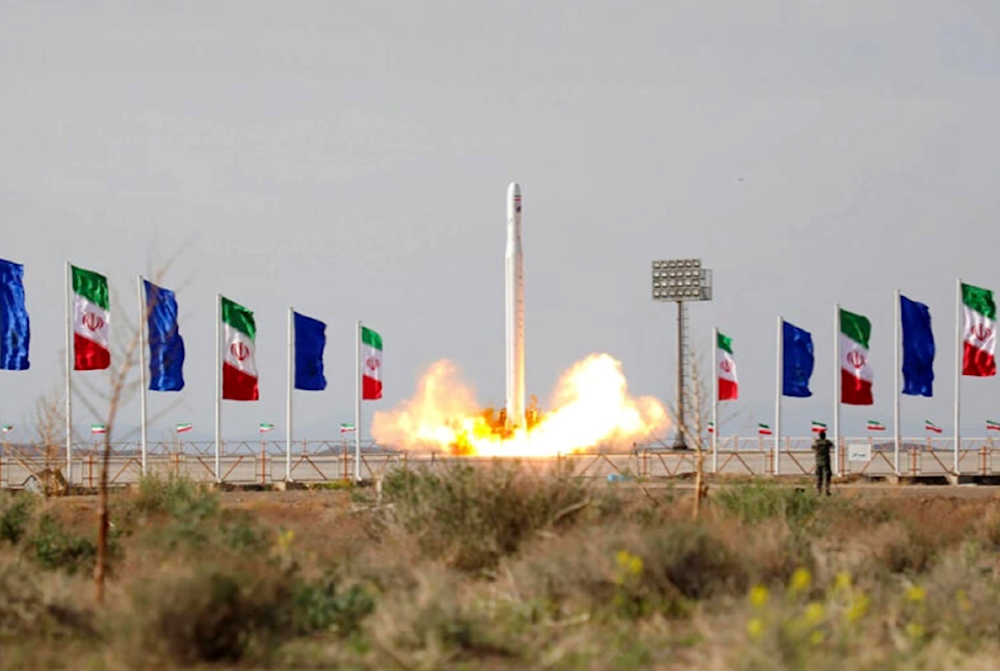Iran sets new space launch record with new Soraya satellite
According to Fars News Agency, the satellite has begun transmitting telemetry data.
-

An Iranian rocket carrying a satellite is launched from an undisclosed location in Iran on April 22, 2020. (AP)
Iran's successful launch of the Soraya satellite 750 km above the earth's surface is the first new space launch record for the country.
The Aerospace Force of Iran's Islamic Revolution Guard Corps (IRGC) reported on Saturday that the Soraya satellite was launched into orbit using its domestically produced Qaem 100 satellite carrier.
In its third test flight, Qaem 100, Iran's first three-stage solid-fueled rocket capable of carrying up to 100 kilograms, successfully launched a research payload weighing around 50 kilograms into orbit.
Major General Hossein Salami, IRGC's chief commander, Hassan Salarieh, head of the Iranian Space Agency, and Brigadier General Amir-Ali Hajizadeh, commander of the IRGC's Aerospace Division attended the launch, which was the first time Iranian satellite carriers reached the 750 km orbit.
According to Fars News Agency, the satellite has begun transmitting telemetry data.
The launch paves the way for numerous subsystems designed by the Iranian Space Research Center to enter the orbital testing phase, smoothing the path for the rapid development of Iran's domestic space sector.
The launch is also a significant step toward boosting the ability to put satellites into higher orbits.
In November, a report by Tasnim news agency reported that Iran was planning to launch five new satellites into space by the end of the Iranian calendar year, March 20, 2024.
The agency quoted Iranian Communications Minister Eisa Zarepour, saying, "We [Iran] will have two satellite launches by the Islamic Revolutionary Guard Corps (IRGC), two launches by the defense ministry, and one launch of a foreign satellite."
Back in October, Zarepour said the country would conduct the first tests of a bio-capsule designed to send astronauts into space in the upcoming months, adding that Iran was working to send a man into space in the next five years.
The month before, he said the IRGC air force had succeeded in launching the third military satellite Noor-3 into orbit. It was later revealed that Iran plans to launch two more satellites into orbit by the end of March 2024.
A new aerospace axis emerges
Iran had previously suspended space manufacturing activities between 2015 and 2017 and later experienced a couple of civilian launch failures in 2019. However, Iran quickly recovered and successfully launched two satellites into orbit in 2020 and March 2022.
In parallel to reports about Russia using Iranian drones in Ukraine gave rise to many fears within the occupation, an Israeli West Asia affairs analyst Seth Frantzman wrote in The Jerusalem Post that Russia is increasingly using Iranian drones in Ukraine, which is a threat that "must be taken seriously" in the international arena, not only in the countries' respective regions.
Frantzman claims that Iran has been exporting either pieces or blueprints of drones to its regional allies, such as Ansar Allah in Yemen, Hezbollah in Lebanon, and Hamas in occupied Palestine. What is notable, however, is that the UAVs are now much more sophisticated than they used to be, with longer ranges and higher precision.
Russia's usage of loitering munition drones developed by Iran against Ukraine is showing the might of the Iranian UAV capabilities, according to the author.
The DPRK has also kickstarted a new space power era. According to official statements, Kim Jong Un declared the launch of a surveillance satellite a "full-fledged exercise of the right to self-defense" during his visit to the National Space Agency. The leader asserted that the newly deployed spy satellite would protect the DPRK from perceived threats posed by "dangerous and aggressive moves of the hostile forces."

 4 Min Read
4 Min Read










